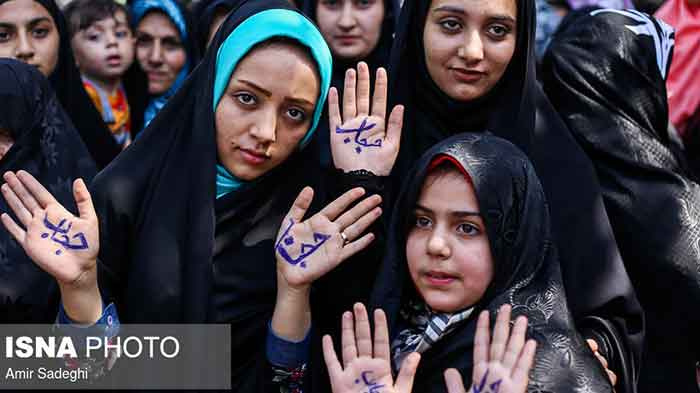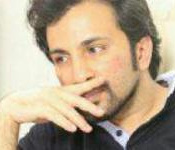Inside Iran, a Diversity of Opinions Emerging over Hijab

On Sunday July 10, 2016, the director of Iran’s Women Basij Society, Minoo Aslani, told a press conference that Iran had declared June 19-25 the “International” week of hijab and chastity. “The week will be celebrated simultaneously in 70 cities across the world0" she was quoted as saying by the semi-official ISNA. "Brochures in different languages will be distributed and interviews will be conducted.”
As part of the week’s programs, thousands have gathered in parades dubbed “Hijab and Chastity” in Isfahan, Qom and several other cities of Iran on the anniversary of the 1935 Goharshad Mosque massacre. The demonstrators demanded the enforcement of regulations on hijab, urging the Judiciary to deal with offenders decisively. The workings on how 21st of Tir (June 10th) has been named the national day of hijab is also a curious question, bordering on distortion of otherwise well-recorded contemporary history. “On 21 of Tir, more than 2000 people, protesting Reza Shah’s Unveiling policy, were martyred in Goharshad Mosque,” she provided. However, the Unveiling, (or Kashf-e Hejab), probably the most radical part of Reza Shah’s Westernization program, came in the form of a decree issued by the monarch on January 8, 1936, i.e. roughly six months after the massacre in Goharshad. Aslani also announced a workshop on hijab and chastity from a neurobiological point of view. Director of Iran’s Women Basij Society said the workshop would discuss the results of a research on the negative impact of inappropriate coverage on the neurological system.
A firm response to the West is at the center of the gesture. Iranian lawmaker Hossein-Ali Haji Deligani, who represents Shahinshahr, a city in the central province of Isfahan, hailed the parades as a measure of value. “The West spends an annual budget of $ 2.5 billion, trying to find ways, particularly through cyberspace and satellite channels, to ruin the character of Muslim women and question the chastity, decency and independence of the genuine Islamic-Iranian culture,” he told the open session of the Iranian parliament, Majlis on Monday July 10, 2016.
Hijab, it constraints and freedoms, always serve as a central theme in electoral campaigns prior to presidential races in Iran since former president the Reformist Mohammad Khatami opened up debates about civil rights in the 1990s. Even a figure as radical as Ahmadinejad dismissed hijab as a major problem for the Iranian youth back in 2005 when he was campaigning for office. Surprisingly, under his term, the moral police in charge of supervising appearances in public came to existence, gradually becoming unalterable and irreversible due to pious sensitivities. Hassan Rouhani, despite being backed in his campaign by the culturally liberal Reformists, has a different history, hijab-wise: he was one of those officials with an instrumental role in establishing compulsory hijab early after the Islamic Revolution. He was assigned to enforce the then unwritten law of hijab in the armed forces. “Women started to make quite a noise when I firmly said “That’s an order and any defiance against it is not allowed”,” he writes in his memoir. The "noise" then was not about wearing chador, but using scarves, covering hair and neck, Rouhani adds.
Hijab, at least in the sense of wearing scarf and avoiding to flash skin, is considered by many as an Iranian tradition that predates the introduction of Islam to Iran. Emphasis on the amalgamation of Iranian and Islamic culture and lifestyle has become vital in the collective identity the establishment promotes. Emerging voices however are breaking the consensus among the establishment elite on compulsion of hijab. In 2015, on the anniversary of the Unveiling, Hassan Khomeini, the grandson of the founder of the Islamic Republic, told a group of Islamic Azad University executives that Ayatollah Khomeini had never recommended people to wear hijab, but they did so with their own discretion. His remarks were met with backlash: critics brought historical facts to prove the re-veiling was a decree issued by the Leader of the Revolution. Months before Hassan Khomeini’s remarks, Seyed Hossein Mousavi Tabrizi, a Reformist religious scholar and former Attorney General under Ayatollah Khomeini, had also shed doubts on the first Supreme Leader’s position on the matter. “We do not even see one case where Imam Khomeini had said that women had to wear hijab,” he told ILNA.
Adherents of the compulsion of hijab usually cite Imam Khomeini’s speech one month after the victory of the revolution, in which he criticized ministries that resembled those of the Pahlavi era, urging women to visit with canonical hijab. They also cite invisible lines read between Ayatollah Khomeini’s answers to questions world-renowned Italian journalist Oriana Fallaci posed during their interview in October 1979.
More recently, influential cleric Ayatollah Nasser Makarem Shirazi issued a extraordinary fatwa allowing female Muslim students studying abroad to quit hijab if their university forbade it and threatened them with their expulsion. In explaining the fatwa, a preference of knowledge to hijab is highlighted, as a means to prevent corrupts and faithless from climbing the social ladder or being appointed to executive posts.
Less major clerics have also taken the debate over compulsory hijab to state TV, despite fiery criticism from the Principlist camp. Sign of the weakening consensus inside the establishment are reflected in the diversity of appearance in Iran’s urban spaces. While a growing population in smaller towns and rural districts are finding it much easier to assert their advocacy of hijab, a Generation Z is rising in cities which is commonly known for its lack of respect for traditional values.


